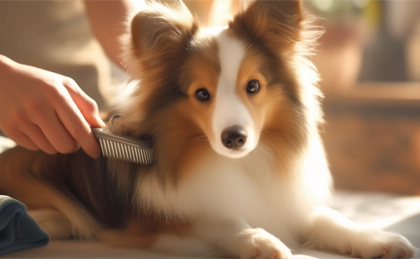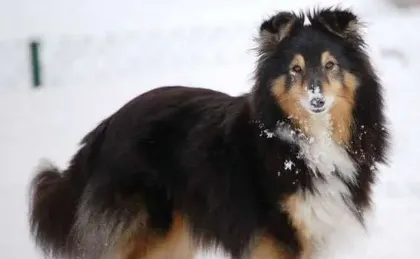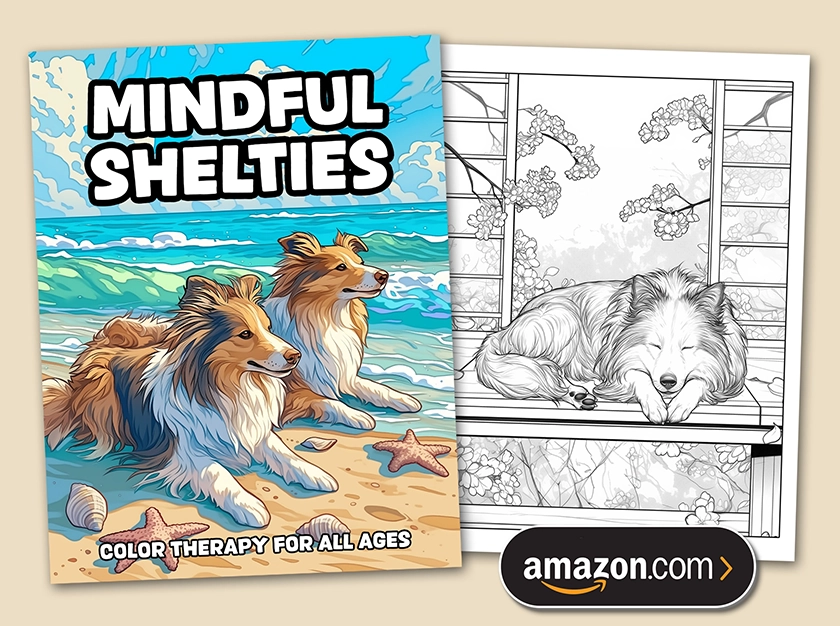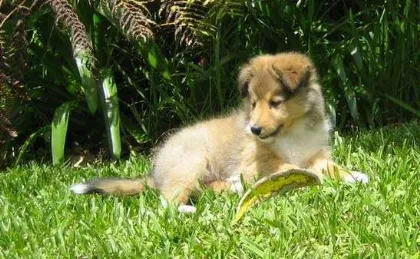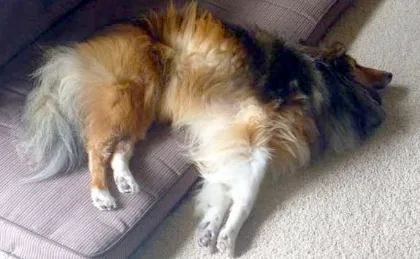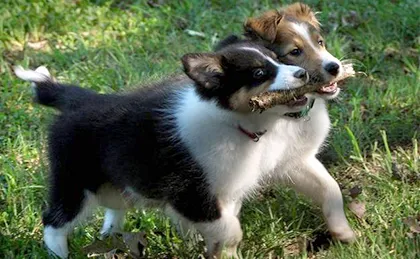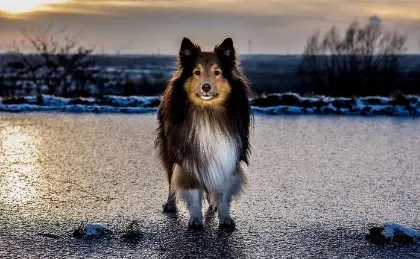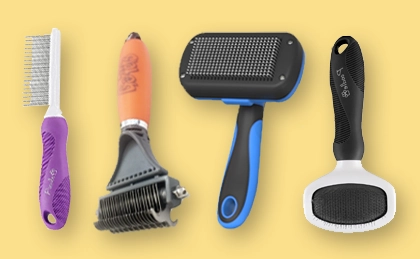Mary Bryant is the owner of Crosswood Shelties, a small hobby kennel in Northeastern South Carolina. Today she shares her experiences of professionally breeding and showing Shetland Sheepdogs, giving us a fascinating glimpse into the life of a Sheltie breeder.
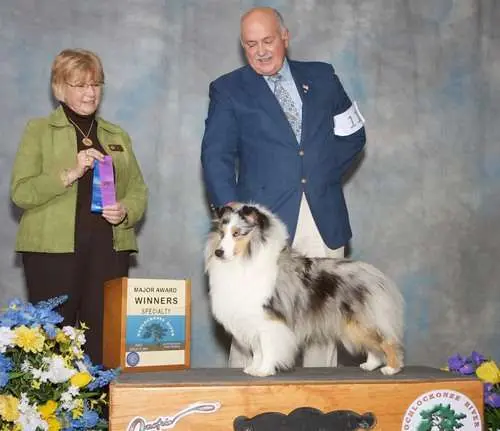
Reno takes the Major Award of Winners Dog (Specialty Show)
Q: Why did you decide to breed Shetland Sheepdogs?
A: This is an easy one—I love them! I grew up in the Lassie era and always wanted a Collie. But my parents wouldn't let me have a dog. We had cats, ducks, fish, turtles, parakeets, ponies and a couple of horses; just about everything but a dog.
When I got married and left home the first priority on my list was to get a Collie. Most new brides would be out buying new furnishings for their new home, but not me! When I was Collie shopping, however, I soon discovered that none of the apartment complexes in Colorado would let you have a larger dog. We finally found an apartment where you could have a dog if it was under 25 pounds...
I had seen what looked like a Collie but in miniature, so I went to the nearest bookstore and bought a book on Shetland Sheepdogs and started reading up on them. I finally found a breeder near me who had a litter and that was when I got my first Sheltie. He was a grandson of CH Halstor's Peter Pumpkin and I was thrilled.
I had Shelties all my adult life from then on but only as pets. I had a young family and we lived in the suburbs so I didn't want to get into breeding, showing and raising them in numbers until I could do it right.
Then eventually my youngest child actually got me into the showing as he was interested in doing juniors. He wound up losing interest after a year but I, on the other hand, was addicted! The rest is history.
Q: How many Shelties do you have at Crosswood?
A: At the moment I have seven adults. I am a stay-at-home mom so I do have more time than most to work with them and give them each individual time each day. Seven is also a good number because I can groom one a day for each day of the week!
Ten is the limit I have set for myself at this point in my life. Perhaps when my youngest son is through school and off to college and I am not tied up with school projects, homework helper and being the taxi mom, I can handle having a few more, but no more than ten at any one time.
With the seven I have now there is a little leeway for any I might want to grow out of any upcoming litters. This doesn't include any litters of puppies I have on the grounds. I don't count them as most of them get placed, only keeping the ones that I feel might make good show prospects to grow out.
Q: How do you decide which puppies to keep?
A: This is a tough question because it comes from knowing and learning through others over the years as to what to look for. Puppies can be hard to assess as they go through so many changes. This is the reason behind growing them out. If a Sheltie puppy looks promising at 10 weeks of age and is still in size by the Nobel Size Chart then I will grow them out for a few months to see whether their promise holds.
The things I look for when choosing one to grow out are a pleasing soft expression, parallel planes, a nice fat chunky round muzzle, plenty of underjaw and finish, a nice clean blunt wedge and of course, a good temperament.
For a show prospect, you want a puppy with a "look at me" attitude with lots of presence and elegance. However, I don't want one that is so out there that they exhibit more of a terrier temperament. I want to see a well balanced puppy with legs set nicely under him on a sound little body.
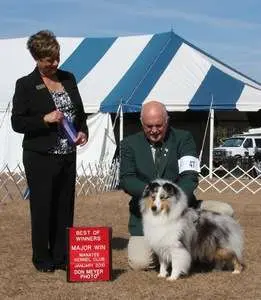
Reno, aka CH Ireland Crosswood Volare Amore, winning Best of Winners!
Movement is a little more difficult to assess at 8 to 10 weeks of age because puppies tend to bounce when they gait. Some are what they refer to as "puppy loose". Until they grow more, their chest drops, and their shoulders lay back and settle, movement issues and angles can change.
Sometimes a little exercise and roadwork can correct some of the movement issues to a degree. But I look for them to stand square: no cow hocks or eastie-westie (toed-out). I also like to feel the sternum a bit beyond the points of shoulder.
Of course none of this means anything if a puppy is over 10 inches in size at 10 weeks because in most lines, especially in males, I find that they're heading to oversize. Keeping all of this in mind, and since I haven't had the years experience in breeding like some, I still gather up the ones I think are worth growing out and take them to my mentor for a second opinion. This helps me learn more and grow in the breed and gives me the opinion of someone who has 35+ years of experience behind them. Yes, I am still learning—and plan to for years to come!
Q: Why do show dogs have such extravagant names and how do you name your Shelties?
A: Usually every registered Sheltie has its so-called everyday name—a "call name" or "kennel" name—that is, whatever you informally choose to call it.
They also have a registered name which is usually comprised of the kennel name of the breeder involved, or in some cases if you sell a show prospect to someone, the name is made up of both parties' kennel names.
For instance, one of my bitch's call name is Reba. She's a red sable Sheltie so I named her after my favorite female country singer, Reba McEntire. Her registered name is Crosswood Country Sunrise Surprise. I might also have informally called her Sunny as part of her registered name.
Some people use a theme to come up with their names. I like country songs so most of mine are named after country songs or a country theme. Sometimes, however, I create the name from the parents.
My foundation AOAC bitch, Angel, is called UKC CH Kirenes Blue Angel. I bred her to CH Windrush Aynsworth Night Sky. And one of the puppies I grew out and kept in that litter is Crosswood Snow Angel By A Misty Moon (I call her Misty). Her grandsire is CH Aynsworth Silver Moonlight, so her name ties in the theme of astrology and combines her dam's name in there too. This is how the names get so long sometimes!
I also like to pick a name that will be memorable if possible. After all, a great Sheltie deserves an extravagant and memorable name!
Q: What were the best lessons learned when you started breeding Shetland Sheepdogs?
A: There wasn't any one thing or group of things that were most important. Everything I have learned is important and has relevance in order to have a successful breeding program.
You definitely need to have an eye for what to look for and knowledge to some degree of the genetics, what tests should be done on all breeding stock, how to read pedigrees, some knowledge of the whelping process, and so on. I am a full believer in seminars and have been known to attend a few of them.
One can NEVER learn enough. I can say this with certainty. I never realized just how much there was to know and learn until I started getting into it, reading, studying, listening, kennel hopping, going to shows, watching videos... and the list goes on.
I was lucky in that I am a former first responder and an EMT so I have helped with birthing a human baby and have watched several being born. Whelping puppies isn't much different! I guess what I'm saying is there are so many important lessons I've learned that it's too hard to single out any in particular.
Q: What happens at dog shoes and how does it all work?
A: Shows are comprised of either one breed of dog which is known as a Specialty Show or all kinds of breeds of dogs which is an All Breed Show. In Shelties there are usually the following classes, divided by sex or variety:
- Puppy Dogs 6 months & Under 9 months
- 9 months & under 12 months
- 12 to 18 month dogs
- Novice dogs
- Amateur-owner handler
- Bred-by Exhibitor dogs
- Am-Bred Dogs
- Open Sable & White dogs
- Open AOAC dogs
- Winners
The same classes are held for bitches as well. Dogs are exhibited first with Winners Dog being selected, then the bitch classes are held after that. The Winners Dog and Winners Bitch class is held at the end of all the classes for each sex and is comprised of the first place winners of all the classes. Then an overall winner is selected for either Winners Dog or Winners Bitch. This is what earns you points.
It takes a total of 15 points to become a conformation champion in the American Kennel Club (AKC). The points are earned based on the number of entries in a show. You have to earn two major wins under two different judges in order to acquire a Championship as part of the 15 point goal. A major win is a 3, 4 or 5 point show.
Under the new point schedule, a 3-point major in my district requires an entry of 13 dogs and 16 bitches to make a 3 point major. It's based on the entries that are actually present that day and doesn't count any absentees. Now if the major breaks and a dog for example is absent and there are only 12 dogs; then the dog can obtain the major points from the bitch points if they take what is called Best of Winners (BOW). That means that out of Winners Dog and Winners Bitch, the judge selects which of the two is closest to the breed standard in their opinion. The bitch will still get her major, but the dog by taking BOW can cross over and assume the major as well.
If you get Winners Dog, you get points towards the Championship based on the number of dog entries that day that were present. The Winners Dog and Winners Bitch then go into the ring for the Best Of Breed Class, which is the final class judged for Shelties. Then the judge selects a Best of Winners between the Winners Dog and Winners Bitch, a Best of Breed, and a Best of Opposite to the Best Of Breed. If the BOB is a male, then he selects the best female for Best of Opposite Sex. Your Best Of Breed winner is the one who will compete in the Herding Group and if they should win the Herding group and take what they call a Group One, then they go in for BEST IN SHOW! Wouldn't we all like to take that honor home one day!
It's important to realize that dogs in a dog show aren't being judged against each other. They are being judged as to how close they represent the breed standard set forth by the parent club and the AKC. There's a lot more to dog showing, but this is just a basic run down on how the competition is done.
Q: What advice would you give to those thinking about becoming Sheltie breeders?
A: Do your homework! Find a great mentor and attach yourself to that person and learn everything you can. Choose someone that is not only willing to give you their time and be helpful, but preferably someone who is more of a veteran at both showing and breeding and has been successful at it.
It's also helpful if your mentor is close enough to where you live or at least within a decent driving distance so you can get together so they can show you how to go over a dog and how to assess them against the standard. They can show you how to properly groom or set ears in a puppy and you can get more hands on experience this way. Some things are just to difficult to understand and grasp over the phone.
I find it best to stick to one mentor, mainly because if you get too many opinions going on, it can get confusing. You need to select someone who you trust, is ethical, has an impeccable reputation, and is most of all honest. It sometimes takes a while to know who those folks really are, but for the most part I have found most Sheltie breeders/exhibitors very approachable and helpful. After all, the new people are the future in the breed. We all started somewhere. Join a breed club if you have one near you.
You must study, read, listen, learn, go to dog shows and seminars, and always keep learning. Persistence is omnipotent. Sheltie breeding is not for the faint of heart. Knowledge comes with time, patience, and experience, and you have to really have a passion for the breed to stick it out. This hobby is never easy, so expect the worst at times, and marvel at the great! The good always outweighs the bad and makes it all worth it—I promise!
Q: What are your hopes for the future as a professional breeder?
A: To breed that perfect Sheltie of course! In reality that will never happen, because there never will be a perfect Sheltie, but I can at least try get close to it. I find breeding Shelties a challenge and I love a challenge. This really is a young breed as far as purebred dogs go, so they just don't always breed true. That's where the challenge comes in.
I take an artsy approach to breeding. Since I am artistically inclined I like to take a creative approach by not just looking at the pedigree but rather breeding type to type, or phenotyping if you will. My dream is to own just one ultimate Sheltie that takes me to the top, be it a dog or bitch. I also want to be a judge one day. I did take one judging class and loved it so that's my ultimate goal when I reach retirement age. But I'll never retire from Shelties. Once owned by a Sheltie, you're owned for life!
